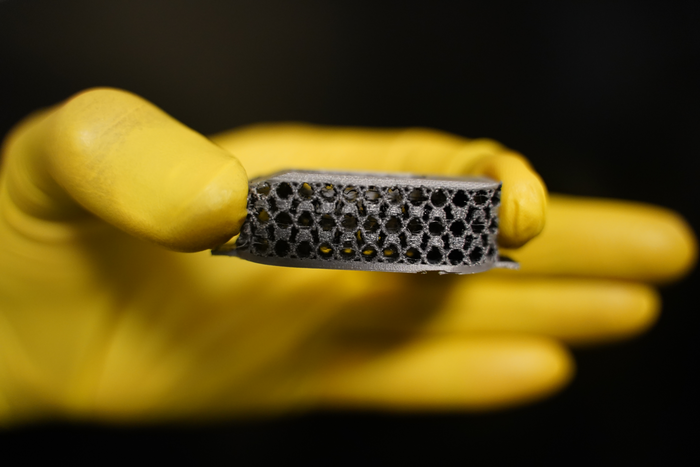Spinal fusion—fusing two vertebrae together—can treat a wide variety of spinal disorders. Often, surgeons will use a cage to provide support where the disk once was between the vertebrae. But what if those cages could support the spine’s healing in more ways than one?

Credit: iSMaRT Lab
Spinal fusion—fusing two vertebrae together—can treat a wide variety of spinal disorders. Often, surgeons will use a cage to provide support where the disk once was between the vertebrae. But what if those cages could support the spine’s healing in more ways than one?
Researchers at the University of Pittsburgh Swanson School of Engineering are creating patient-specific 3D-printed smart metamaterial implants that double as sensors to monitor spinal healing. A paper detailing their work was recently published in the journal Advanced Functional Materials.
“Smart implants can provide real-time biofeedback and offer many therapeutic and diagnostic benefits,” said Amir Alavi, assistant professor of civil and environmental engineering, whose iSMaRT Lab led the research. “But it is very challenging to integrate bulky circuits or power sources into the small area of implants. The solution is to use the implant matrix as an active sensing and energy harvesting medium. That’s what we’ve been focused on.”
The Intelligent Structural Monitoring and Response Testing (iSMaRT) Lab has developed a new class of multifunctional mechanical metamaterials, which act as their own sensors, recording and relaying important information about the pressure and stresses on its structure. The so-called “meta-tribomaterials” a.k.a. self-aware metamaterials, generate their own power and can be used for a wide array of sensing and monitoring applications.
The material is designed such that under pressure, contact-electrification occurs between its conductive and dielectric microlayers, creating an electric charge that relays information about the condition of the material matrix. In addition, it naturally inherits the outstanding mechanical tunability of standard metamaterials. The power generated using its built-in triboelectric nanogenerator mechanism eliminates the need for a separate power source, and a tiny chip records data about the pressure on the cage, which is an important indicator of healing. The data can then be read noninvasively using a portable ultrasound scanner.
Not only is the proposed cage unique in its sensing capabilities, but it’s also made of a highly tunable material that can be customized to the patient’s needs.
“Spinal fusion cages are being widely used in spinal fusion surgeries, but they’re usually made of titanium or PEEK polymer materials (a semi-crystalline, high-performance engineering thermoplastic) with certain mechanical properties,” explained Alavi. “The stiffness of our metamaterial interbody cages can be readily tuned. The implant can be 3D-printed based on the patient’s specific anatomy before surgery, making it a much more natural fit.”
The team has successfully tested the device in human cadavers and are looking to move on to animal models next. Because the material itself is incredibly tunable and scalable, the smart sensor design could be adapted to many other medical applications in the future, like cardiovascular stents or components for knee or hip replacements.
“This is a first-of-its-kind implant that leverages advances in nanogenerators and metamaterial to build multifunctionality into the fabric of medical implants,” said Alavi. “This technological advancement is going to play a major part in the future of implantable devices.”
The paper, “Patient-Specific Self-Powered Metamaterial Implants for Detecting Bone Healing Progress,” (DOI: 10.1002/adfm.202203533) was published in Advanced Functional Materials. It was coauthored by researchers and surgeons at the University of Pittsburgh, Georgia Institute of Technology, the Beijing Institute of Nanoenergy and Nanosystems, and the Allegheny Health Network Department of Neurosurgery.
Journal
Advanced Functional Materials
DOI
10.1002/adfm.202203533
Article Title
Patient-Specific Self-Powered Metamaterial Implants for Detecting Bone Healing Progress




